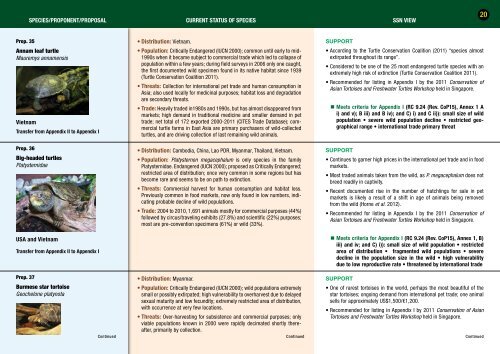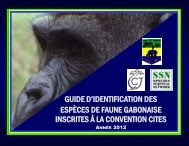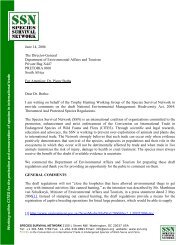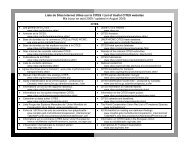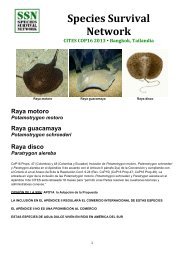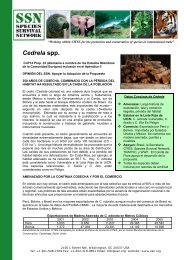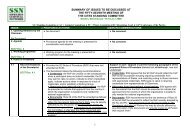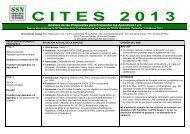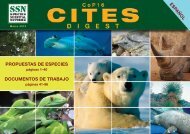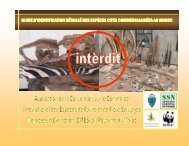CITES CoP16 Digest - Species Survival Network
CITES CoP16 Digest - Species Survival Network
CITES CoP16 Digest - Species Survival Network
Create successful ePaper yourself
Turn your PDF publications into a flip-book with our unique Google optimized e-Paper software.
SPECIES/PROPONENT/PROPOSAL CURRENT STATUS OF SPECIES SSN VIEW<br />
20<br />
Prop. 35<br />
Annam leaf turtle<br />
Mauremys annamensis<br />
Vietnam<br />
Transfer from Appendix II to Appendix I<br />
Prop. 36<br />
Big-headed turtles<br />
Platysternidae<br />
USA and Vietnam<br />
Transfer from Appendix II to Appendix I<br />
• Distribution: Vietnam.<br />
• Population: Critically Endangered (IUCN 2000); common until early to mid-<br />
1990s when it became subject to commercial trade which led to collapse of<br />
population within a few years; during field surveys in 2006 only one caught,<br />
the first documented wild specimen found in its native habitat since 1939<br />
(Turtle Conservation Coalition 2011).<br />
• Threats: Collection for international pet trade and human consumption in<br />
Asia; also used locally for medicinal purposes; habitat loss and degradation<br />
are secondary threats.<br />
• Trade: Heavily traded in1980s and 1990s, but has almost disappeared from<br />
markets; high demand in traditional medicine and smaller demand in pet<br />
trade; net total of 172 exported 2000-2011 (<strong>CITES</strong> Trade Database); commercial<br />
turtle farms in East Asia are primary purchasers of wild-collected<br />
turtles, and are driving collection of last remaining wild animals.<br />
• Distribution: Cambodia, China, Lao PDR, Myanmar, Thailand, Vietnam.<br />
• Population: Platysternon megacephalum is only species in the family<br />
Platysternidae. Endangered (IUCN 2000); proposed as Critically Endangered;<br />
restricted area of distribution; once very common in some regions but has<br />
become rare and seems to be on path to extinction.<br />
• Threats: Commercial harvest for human consumption and habitat loss.<br />
Previously common in food markets, now only found in low numbers, indicating<br />
probable decline of wild populations.<br />
• Trade: 2004 to 2010, 1,691 animals mostly for commercial purposes (44%)<br />
followed by circus/traveling exhibits (27.8%) and scientific (22%) purposes;<br />
most are pre-convention specimens (61%) or wild (33%).<br />
SUPPORT<br />
• According to the Turtle Conservation Coalition (2011) “species almost<br />
extirpated throughout its range”.<br />
• Considered to be one of the 25 most endangered turtle species with an<br />
extremely high risk of extinction (Turtle Conservation Coalition 2011).<br />
• Recommended for listing in Appendix I by the 2011 Conservation of<br />
Asian Tortoises and Freshwater Turtles Workshop held in Singapore.<br />
• Meets criteria for Appendix I (RC 9.24 (Rev. CoP15), Annex 1 A<br />
i) and v); B iii) and B iv); and C) i) and C ii)): small size of wild<br />
population • severe wild population decline • restricted geographical<br />
range • international trade primary threat<br />
SUPPORT<br />
• Continues to garner high prices in the international pet trade and in food<br />
markets.<br />
• Most traded animals taken from the wild, as P. megacephalum does not<br />
breed readily in captivity.<br />
• Recent documented rise in the number of hatchlings for sale in pet<br />
markets is likely a result of a shift in age of animals being removed<br />
from the wild (Horne et al. 2012).<br />
• Recommended for listing in Appendix I by the 2011 Conservation of<br />
Asian Tortoises and Freshwater Turtles Workshop held in Singapore.<br />
• Meets criteria for Appendix I (RC 9.24 (Rev. CoP15), Annex 1, B)<br />
iii) and iv; and C) i)): small size of wild population • restricted<br />
area of distribution • fragmented wild populations • severe<br />
decline in the population size in the wild • high vulnerability<br />
due to low reproductive rate • threatened by international trade<br />
Prop. 37<br />
Burmese star tortoise<br />
Geochelone platynota<br />
• Distribution: Myanmar.<br />
• Population: Critically Endangered (IUCN 2000); wild populations extremely<br />
small or possibly extirpated; high vulnerability to overharvest due to delayed<br />
sexual maturity and low fecundity; extremely restricted area of distribution,<br />
with occurrence at very few locations.<br />
• Threats: Over-harvesting for subsistence and commercial purposes; only<br />
viable populations known in 2000 were rapidly decimated shortly thereafter,<br />
primarily by collection.<br />
SUPPORT<br />
• One of rarest tortoises in the world, perhaps the most beautiful of the<br />
star tortoises; ongoing demand from international pet trade; one animal<br />
sells for approximately US$1,500/€1,200.<br />
• Recommended for listing in Appendix I by 2011 Conservation of Asian<br />
Tortoises and Freshwater Turtles Workshop held in Singapore.<br />
Continued Continued Continued


